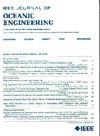Enhancing Generalization of Active Sonar Classification Using Semisupervised Anomaly Detection With Multisphere for Normal Data
IF 3.8
2区 工程技术
Q1 ENGINEERING, CIVIL
引用次数: 0
Abstract
Anomaly detection is suitable for active sonar classification due to its ability to handle the challenges posed by small imbalanced data sets. Recently, a modified anomaly detection approach called bisphere anomaly detection (BiSAD) has been developed for active sonar classification and has demonstrated improved generalization performance over conventional deep-learning-based methods. However, BiSAD has some limitations: multimodalities of clutter distribution induce unnecessary redundancy in the clutter manifold, and the inconsistency of two encoder outputs causes instability during learning. We propose a modified version of BiSAD called multisphere anomaly detection (MulSAD), which incorporates clustering and regularization. Clustering is used to model the multimodal distribution of the clutter samples, whereas regularization ensures consistency in the manifold learning of the two encoders. Two active sonar data sets generated in two different ocean experiments with different environments are used alternatively as the training/validation and test data sets. The efficacy of the modifications is confirmed by analyzing the classification performance according to hyperparameters. In the generalization test, MulSAD outperforms both the supervised-learning-based deep learning methods and BiSAD. Furthermore, MulSAD is more robust to mislabeled data samples in the training data sets.利用针对正常数据的多球体半监督异常检测增强主动声纳分类的通用性
异常检测适用于主动声纳分类,因为它能够应对小型不平衡数据集带来的挑战。最近,针对主动声纳分类开发了一种名为双球异常检测(BiSAD)的改进型异常检测方法,与传统的基于深度学习的方法相比,该方法的泛化性能有所提高。然而,BiSAD 有一些局限性:杂波分布的多模态性会在杂波流形中产生不必要的冗余,两个编码器输出的不一致性会导致学习过程中的不稳定性。我们提出了一种经过改进的 BiSAD,称为多球异常检测(MulSAD),它结合了聚类和正则化。聚类用于模拟杂波样本的多模态分布,而正则化则确保两个编码器流形学习的一致性。在两个不同环境的海洋实验中生成的两个主动声纳数据集交替用作训练/验证和测试数据集。通过分析超参数的分类性能,证实了修改的有效性。在泛化测试中,MulSAD 的表现优于基于监督学习的深度学习方法和 BiSAD。此外,MulSAD 对训练数据集中的错误标注数据样本具有更强的鲁棒性。
本文章由计算机程序翻译,如有差异,请以英文原文为准。
求助全文
约1分钟内获得全文
求助全文
来源期刊

IEEE Journal of Oceanic Engineering
工程技术-工程:大洋
CiteScore
9.60
自引率
12.20%
发文量
86
审稿时长
12 months
期刊介绍:
The IEEE Journal of Oceanic Engineering (ISSN 0364-9059) is the online-only quarterly publication of the IEEE Oceanic Engineering Society (IEEE OES). The scope of the Journal is the field of interest of the IEEE OES, which encompasses all aspects of science, engineering, and technology that address research, development, and operations pertaining to all bodies of water. This includes the creation of new capabilities and technologies from concept design through prototypes, testing, and operational systems to sense, explore, understand, develop, use, and responsibly manage natural resources.
 求助内容:
求助内容: 应助结果提醒方式:
应助结果提醒方式:


